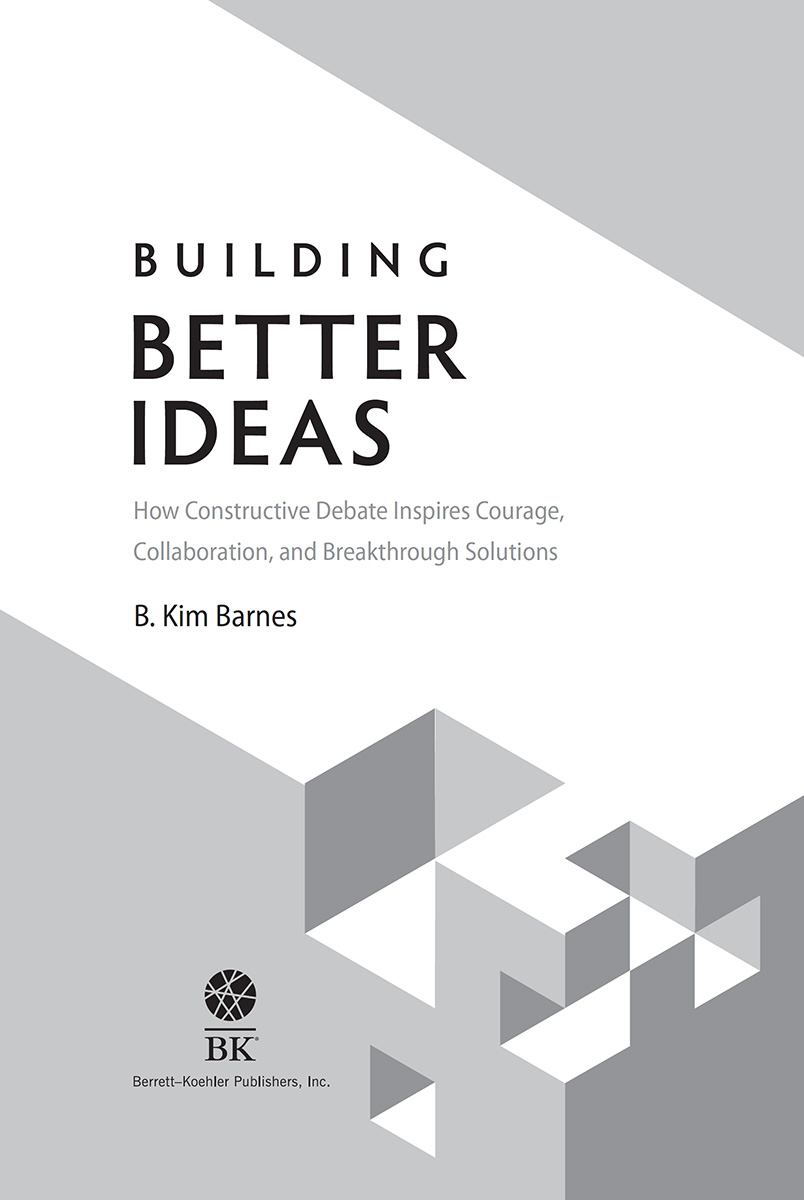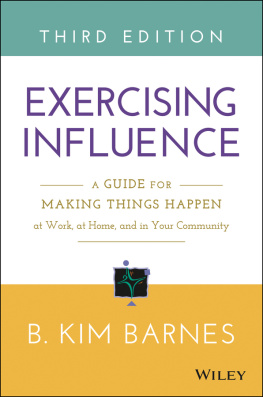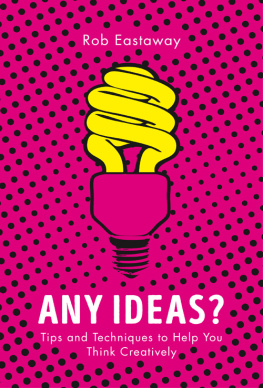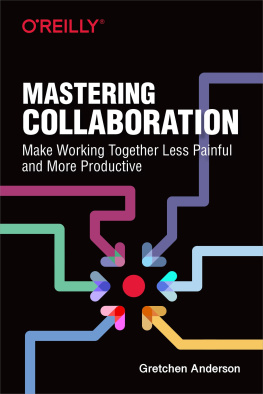BUILDING
BETTER IDEAS

Building Better Ideas
Copyright 2019 by B. Kim Barnes
All rights reserved. No part of this publication may be reproduced, distributed, or transmitted in any form or by any means, including photocopying, recording, or other electronic or mechanical methods, without the prior written permission of the publisher, except in the case of brief quotations embodied in critical reviews and certain other noncommercial uses permitted by copyright law. For permission requests, write to the publisher, addressed Attention: Permissions Coordinator, at the address below.

| Berrett-Koehler Publishers, Inc.
1333 Broadway, Suite 1000
Oakland, CA 94612-1921
Tel: (510) 817-2277, Fax: (510) 817-2278
www.bkconnection.com |
Ordering information for print editions
Quantity sales. Special discounts are available on quantity purchases by corporations, associations, and others. For details, contact the Special Sales Department at the Berrett-Koehler address above.
Individual sales. Berrett-Koehler publications are available through most bookstores. They can also be ordered directly from Berrett-Koehler: Tel: (800) 929-2929; Fax: (802) 864-7626; www.bkconnection.com
Orders for college textbook/course adoption use. Please contact Berrett-Koehler: Tel: (800) 929-2929; Fax: (802) 864-7626.
Distributed to the U.S. trade and internationally by Penguin Random House Publisher Services.
Berrett-Koehler and the BK logo are registered trademarks of Berrett-Koehler Publishers, Inc.
First Edition
Paperback print edition ISBN 978-1-5230-8558-3
PDF e-book ISBN 978-1-5230-8559-0
IDPF e-book ISBN 978-1-5230-8560-6
Digital audio ISBN 978-1-5230-8562-0
2019-1
Book producer: Westchester Publishing Services
Text designer: Courtney Baker
Cover designer: Paula Goldstein
This book is dedicated to the memory of Margaret Fuller, an American journalist, author, and promoter of intelligent Conversations among men and women in the early nineteenth century. A friend of Ralph Waldo Emerson, Henry David Thoreau, Horace Mann, and other luminaries of her time, she sought recognition for women as intellectual equals and encouraged her friends and those she mentored, male and female, to speak up and speak out on important questions of her era.
I also dedicate this book to my supportive team and associates at Barnes & Conti, especially Rebecca Hendricks, who worked closely with me to develop the concepts discussed in this book. Rebecca offers me the essential combination of support and challenge whenever we collaborate. I am grateful for all our constructive debates.
B. Kim Barnes
Contents
BUILDING
BETTER IDEAS
Introduction
Why Do We Always Have to Have
The Meeting After the Meeting?
Its three oclock. Your product development team meeting has just ended. And here you are in the break room with most of the other team members.
Can you believe what Jason just proposed?
I can. Its the same thing hes proposed for the last four meetings.
Only the names were changed to protect the guilty!
Does he even know what century were in? Thats three product cycles ago, for two of our competitors.
I could have told him that idea will never fly in todays market.
I have a much better idea, but hed never go for it.
So, why didnt anybody say anything?
Hes the boss.
Meanwhile, near the managers office...
Nobody had any ideas today, as usual. I think people are just checked out.
Maybe we need some different peoplemore creative ones?
I doubt that we could attract any real innovators. The culture seems to reward people who dont rock the boat.
If any of this sounds familiar, youre not alone. Ideas are the lifeblood of organizations in the current climate; but having a constant flow of new and interesting ideas to explore, develop, test, and bring to market is not a given. Three major factors contribute to the dearth of great ideas:
First, few ideas are great to begin with. They have to be questioned, critiqued, improved, and developed, and then they must compete with other ideas for support, commitment, and resources.
Second, few people have been well trained in the skills that enable them to work with their own and others ideas in a tough, honest, competitive, and yet collaborative way.
And third, organizational politics, tribal loyalties, and human emotions such as fear of loss are a powerful, yet sometimes invisible, factor in communication and decision-making within organizations.
What Do We Mean When We Use the Word Idea?
An idea, at least in the sense we use the word in organizations, is a thought or opinion that is formulated and can be expressed. Ideas are the way we frame our thinking about a specific topic. Some ideas are fixedwe form them early and seldom change them. They become part of our worldview and are the basis for testing the truth of other information or opinions. Other ideas are more tentative, less solid, and open to new experiences, experiments, or the influence of other people.
In a time when innovationthat is, creating value from an idea thats new to youis key to the success of many organizations, high-quality Those investments can best pay off when potential innovators thrive in welcoming environments. Organizations will risk obsolescence or failure if they cant respond with new and powerful ideas to customer needs, changing technology, social and cultural movements, competitive pressure, political or environmental crises, and unexpected opportunities.
So, Whose Job Is It to Generate Ideas?
While generating ideas is seldom part of a formal job description, its hard to think of a job where that skill wouldnt be relevant. Anyone who has worked in an organization will be aware that a large proportion of problems that frontline employees face will never reach the senior executive level. Its common wisdom that t hose who are closest to the problem or opportunity are in the best position to deal with it. If the only person with the responsibility and permission to generate ideas is a formal leader or a designated professional, there are probably too many people in the room. Any organization can benefit from a workforce that is both expected to be and skillful in being creative and forthcoming with suggestions and proposals.
A few years ago, a large client organization approached me with a need that they described in the following way: We need to get rid of the meeting after the meeting where people discuss what they really thought and felt during the actual meeting, but didnt say. We want to help our people stop bad ideas from getting a pass, and then encourage them to put new ideas forward, even if they might be partial and unbakedor at least very different from our current common wisdom. Can you develop a training program that would help with this?
On hearing the presenting issues, I first explored with them the possibility that they were looking for skills in interpersonal or intergroup communication or perhaps in conflict resolution. While my own company had existing programs in those arenas, it soon became clear to all of us that the issue was not really conflict, but rather the
Next page










